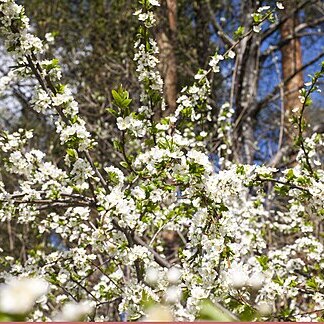Trees 2.5–3 m tall. Branches grayish black, robust, glabrous; branchlets reddish brown, glabrous. Winter buds reddish brown, usually glabrous. Stipules lanceolate, margin glandular serrate, apex acuminate. Petiole glabrous, without nectaries; leaf blade obovate-oblong, rarely elliptic, 4–7(–9) × 2–4 cm, abaxially pale green and basally sparsely pubescent, adaxially dark green and basally sparsely pubescent, base cuneate to rarely broadly cuneate, margin serrate or biserrate with teeth often gland-tipped, apex caudate, acuminate, or acute; midvein and secondary veins abaxially conspicuous and raised, adaxially impressed. Flowers 2 or 3 in a fascicle, rarely solitary, 1–1.2 cm in diam. Pedicel 0.7–1.3 cm, glabrous. Hypanthium outside glabrous. Sepals oblong, glabrous, margin gland-tipped serrulate, apex acute. Petals white, oblong, base cuneate and shortly clawed, margin undulate near apex. Ovary glabrous. Stigma disc-shaped. Drupe purplish red, ovoid, subglobose, or oblong, 1.5–2.5 cm in diam., glabrous; endocarp oblong, conspicuously grooved, inconspicuously pitted. Fl. Apr–May fr. Jun–Sep.
More
A small tree. It grows 3 m tall. The leaves are oval and 4-7 cm long by 2-4 cm wide. They are pale green underneath. The flowers are in groups of 2 or 3 and are 1 cm across. The petals are white. The fruit are purplish red. They are oval and 1.5-2.5 cm across.

